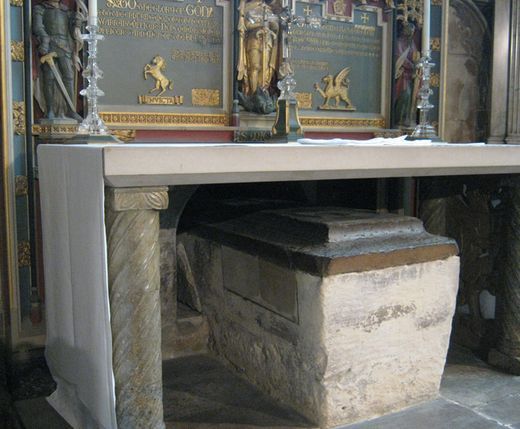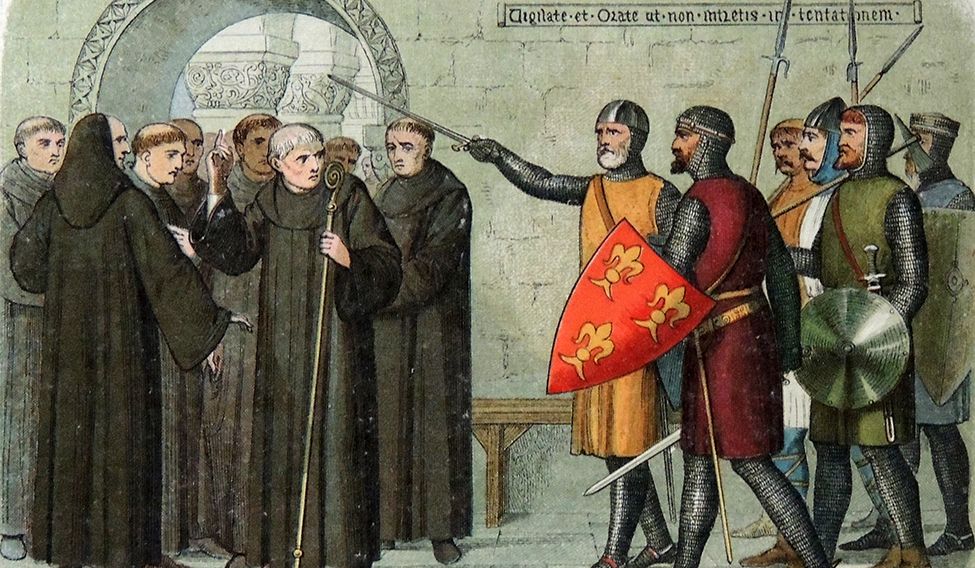They were just a troop of unwashed and unabashed warmongers, fighting for their fiefs and privileges, and not caring two hoots for their serfs. Some had pretensions of chivalry, but had been notorious for their barbaric conduct in the crusades against Muslims, whom they called Moors. They had no great leader with vision, yet what they did and achieved while in pursuit of their self-interest, laid the foundation for the rise of rights.
And they also had an ally. One who, in the words of G.M. Trevelyan, “had both moral and intellectual greatness”—Archbishop Stephen Langton. He gave the intellectual ballast to what otherwise would have been a street revolt of a few barons. “Langton argued that God had not intended the world to be ruled by kings, who were predisposed to rule oppressively and with disregard for the law,” says Sophie Ambler of the University of East Anglia.
Langton was teaching in the University of Paris when Pope Innocent III took him to Rome and ordained him cardinal. When the archbishop of Canterbury died in 1205, two factions in the church elected two bishops as archbishop. The pope quashed both the elections; in a fresh poll held in his presence in Rome in 1207, he got Langton elected.
This enraged King John, who had backed one faction. He proclaimed that anyone who recognised Langton would be treated as public enemy, and expelled a few pro-Langton monks. In March 1208, the pope placed England under interdict, by which the entire country and its people remained outside the church. In 1213, the Pope asked King Philip II of France, who had ambitions over England, to depose John.
As Philip mobilised his army to invade England, most English barons, who had been unhappy with John's tyrannical ways, joined him. John yielded, and allowed Langton to enter England and promised to repeal his unjust laws.
Once the threat from France receded, John forgot his promises. This enraged the barons. They rallied around Langton, who convened a council of churchmen and barons at Westminster on August 25, 1213. There he read the text of a liberal charter of laws that King Henry II, John's father, had given, and called for its renewal. And he counted on the help of the pope, to whom John had broken his promises.
But the pope changed sides. His argument was that the king was his vassal. He excommunicated the barons, and suspended Langton from church duties. By then, the rebellion had gathered steam. The rebel barons marched to London, and the rest is history.
Langton has written several sermons and commentaries, expositions and treatises on almost all the books of the Old Testament. Most of them are preserved in manuscript at Lambeth Palace, Oxford and Cambridge, and in France. Langton is believed to be the one who divided the Bible into the standard, modern arrangement of chapters. Langton, wrote Trevelyan, “was all the greater man because his support of the constitutional cause was contrary to the wishes of the great Pope Innocent III, who, in return for John's politic submission in 1213, backed him at every turn in his quarrel with his subjects and declared Magna Carta null and void. Considering that Stephen Langton owed his election to Canterbury to the pope's support, his stoutness on political questions in England was doubly remarkable.”
Among the barons, the most prominent was Robert Fitzwalter, popularly credited as the first champion of English liberty. Fitzwalter and 24 other barons are named in the Great Charter as its guarantors. Another 12 bishops, around 20 abbots, mostly neutral men, stood witness to the agreement between the king and the barons.
Fitzwalter clashed with John after the king tried to seduce his daughter Matilda. The proud father-daughter duo are subjects of several legends. One story has it that John poisoned her, and the father avenged her honour by humiliating the king at Runnymede.
To escape the wrath of the king, Fitzwalter fled to France and returned to join the rebels. He was elected their leader and conferred the title 'Marshal of the Army of God'. He chose London as the base of the rebel operations, prepared the city for war against the king, and sought the help of Prince Louis of France. In the battle of Lincoln, the king's forces captured Fitzwalter, but released him soon afterwards.
After John's death, Fitzwalter served his successor Henry III and joined the Fifth Crusade. Many believe that the Robin Hood of the fables was actually Robert Fitzwalter.
Eustace de Vesci, who was with Richard the Lionheart in Palestine in 1191, also turned against John after the king tried to seduce his wife. He fled to Scotland in 1212 fearing John's wrath. His lands were seized, but after John's submission to the pope, he returned to England, on condition that he would not trouble the king.
But he did. He was a leader in the First Barons' War in 1215, marching south against John with Robert Fitzwalter. He died during the siege of Barnard Castle, where he was shot through the head with an arrow.
Another prominent rebel was William d'Aubigny, Lord of Belvoir. He was initially neutral, but joined the rebels after they took London. King John captured him in the war that followed the signing of the charter and put him in prison. He became a crown loyalist after Henry III ascended the throne.
Most of the rebels had actually been staunch royalists. It was only John's conduct that put them off. Roger Bigod, second earl of Norfolk, had been a loyalist of Richard the Lionheart, who had confirmed his earldom, which had been a matter of dispute. He had also been Richard's ambassador to France, and when Richard was taken hostage while on his way back from the Third Crusade, Bigod negotiated his release. Roger's son Hugh, third earl of Norfolk, was also a guarantor of Magna Carta. The father and son were excommunicated by the pope in December 1215.
Many changed sides as the fortunes of the war changed. William de Forz, third earl of Albemarle, described by historian William Stubbs as “a feudal adventurer of the worst type”, was loyal to John initially, and joined the rebels only after the king lost support of London. He changed sides twice more. After John's death, Albemarle supported the new king, Henry III, and rose to high posts in the realm.
 Here rests a noble soul: Stephen Langton's crypt at Canterbury Cathedral in Kent | R. Prasannan
Here rests a noble soul: Stephen Langton's crypt at Canterbury Cathedral in Kent | R. Prasannan
Another guarantor was Henry de Bohun, first earl of Hereford, who was the constable of England. The king's forces captured him in the battle of Lincoln in 1217. Richard de Clare, third earl of Hertford, had professed loyalty to John at Northampton, but joined the rebel barons. In the subsequent war, he was one of the commissioners sent by the barons to negotiate a truce. His son Gilbert, fifth earl of Gloucester, was taken prisoner in 1217 by the commander of the king's forces, William Marshal (see story on page 44). Later he married Marshal's daughter Isabel. Gilbert was one of the few who were present when Henry III confirmed Magna Carta in 1225. Another baronial guarantor was John FitzRobert de Clavering, Lord of Warkworth Castle, about whom little is known.
One of the main events that changed the course of the war against John was when William Hardell, Mayor of London, opened the city gates to the rebels. The rebels rewarded the city by inserting a specific clause in the charter, which said London will have all its ancient liberties and free customs both by land and by water.
Another event that changed the tide in the rebels' favour was the support of the French. Many barons deserted the king when this happened. Prominent among them was William of Huntingfield, high sheriff of Norfolk and Suffolk.
An early rebel was John de Lacy, second earl of Lincoln, seventh baron of Halton Castle, fifth lord of Bowland and hereditary constable of Chester. He was excommunicated by the pope. He later joined a pilgrimage to the Holy Land.
The next guarantor, William de Lanvallei III, was a late rebel. He even accompanied John on his expedition to Poitou in 1214 and then changed sides. Another little known guarantor was William Malet, the lord of Curry Mallet and Shepton Mallet in Somerset. Then there was Geoffrey FitzGeoffrey de Mandeville, second earl of Essex and sixth earl of Gloucester.
William Marshal, second earl of Pembroke [he also appears in the Shakespeare play King John], was on the side of the rebels, while his father was fighting for the king. When French forces captured Worcester Castle in 1216, the father warned him of a counter-attack from the royal forces, and he fled. In March 1217, he changed sides and joined the father in fighting for the king. The young man later rose to be one of the most powerful lords of the realm.
Roger de Montbegon, baron of Hornby, entered the list of sureties by mistake. It is said the chronicler Matthew Paris made a mistake in replacing his name with 'Roger de Mowbray'. Richard de Montfichet was excommunicated by the pope in 1216 for fighting against the king. He returned to the royal side in 1217 after being taken prisoner in the battle of Lincoln.
Another grand rebel was William de Mowbray, described as small as a dwarf but very generous and valiant. He fought many a battle on the side of King Richard in the Holy Land and France. Most barons essentially were not anti-royal, but just anti-John, like Sir Richard de Percy, fifth baron of Percy. They fought against John, but upon his death, made peace with his son Henry III, and loyally served the king, crown and England.
Family ties often decided who was with who. Saer de Quincy, first earl of Winchester, fought against John because the commander of the rebel army, Robert Fitzwalter, was his cousin. Later he joined the Fifth Crusade, and died in Acre, the capital of the Kingdom of Jerusalem. His heart was brought back and interred at Garendon Abbey near Loughborough, a house endowed by his wife's family.
Sir Robert de Ros [also spelt Roos] of Helmsley, joined the barons at Stamford, but when Henry III ascended the throne, he declared allegiance to the crown. Little is known about Geoffrey de Saye, another guarantor, except that he was the son of Geoffrey de Saye, lord of West Greenwich.
Often, brothers, too, were found on opposing sides. Robert de Vere, was brother and heir to his brother, Aubrey de Vere, who was one of the “evil councillors” of John.
Much less is known about the churchmen who witnessed the charter than about the barons. Many historians believe that the guarantors (all barons) were all against the king, but the churchmen, except Langton, were neutral witnesses.
A prominent churchman was Henry de Loundres, archbishop of Dublin, who helped complete the building of the Dublin Castle in 1230 and put out the flame kept burning in Kildare Abbey, saying it was a pagan symbol. Then there was William of Sainte-Mere-Eglise, bishop of London, who was one of the two men (the other was Hubert Walter, bishop of Salisbury) who found King Richard I lying in captivity at Ochsenfurt in Germany. Jocelin of Wells, bishop of Bath and Wells, sided with the king when he clashed with Pope Innocent III, but later advised the king to patch up with the pope. This made him, along with Gilbert Glanvill, the bishop of Rochester, the subject of a mocking song. Jocelin finally went over to the rebel side in 1214. Peter des Roches, bishop of Winchester, was known as the 'butterfly bishop' because there is a story in The Lanercost Chronicle that he once met the legendary King Arthur in the forest, and asked for a token of their meeting. Arthur told him to close his hand, then open it. When he did, a butterfly flew out.
Another prominent witness was Hugh de Wells, bishop of Lincoln and keeper of the great seal. Herbert Poore, bishop of Salisbury, had attended King John's coronation on May 27, 1199. Then there were Benedict of Sausetun, bishop of Rochester; Walter de Gray, bishop of Worcester, who rose to be archbishop of York and lord chancellor; Geoffrey de Burgo, bishop of Ely; Hugh de Mapenor, bishop of Hereford; and Richard Poore, bishop of Chichester.
Plus the abbots of St Edmunds, St Albans (Bello), St Augustine's in Canterbury, Evesham, Westminster, Peterborough, Reading, Abington, Malmesbury Abbey, Winchcomb, Hyde, Chertsey, Sherborne, Cerne, Abbotebir, Middleton, Selby, Cirencester and Hartstary.







